Electrochemically Activated Screen-Printed Carbon Sensor Modified with Anionic Surfactant (aSPCE/SDS) for Simultaneous Determination of Paracetamol, Diclofenac and Tramadol
Abstract
:1. Introduction
2. Materials and Methods
2.1. Apparatus
2.2. Reagents and Solutions
2.3. Preparation of aSPCE/SDS
2.4. Voltammetric Analysis
2.5. HPLC/PDA Analysis
2.6. Real Sample Analysis
3. Results and Discussion
3.1. Microscopic and Electrochemical Characteristic of Sensors
3.2. Influence of pH
3.3. Adsorption Studies
3.4. Optimization of Procedure Parameters
3.5. Selectivity
3.6. Analytical Characteristic
3.7. Sample Analysis
4. Conclusions
Author Contributions
Funding
Institutional Review Board Statement
Informed Consent Statement
Data Availability Statement
Conflicts of Interest
References
- Yunusoğlu, O.; Allahverdiyeva, S.; Yardım, Y.; Şentürk, Z. A simple approach to simultaneous electroanalytical quantification of acetaminophen and tramadol using a boron-doped diamond electrode in the existence of sodium dodecyl sulfate. Electroanalysis 2020, 32, 429–436. [Google Scholar] [CrossRef]
- Sasal, A.; Tyszczuk-Rotko, K.; Wójciak, M.; Sowa, I.; Kuryło, M. Simultaneous analysis of paracetamol and diclofenac using MWCNTs-COOH modified screen-printed carbon electrode and pulsed potential accumulation. Materials 2020, 13, 3091. [Google Scholar] [CrossRef] [PubMed]
- Cao, F.; Dong, Q.; Li, C.; Chen, J.; Ma, X.; Huang, Y.; Song, D.; Ji, C.; Lei, Y. Electrochemical sensor for detecting pain reliever/fever reducer drug acetaminophen based on electrospun CeBiOx nanofibers modified screen-printed electrode. Sens. Actuators B 2018, 256, 143–150. [Google Scholar] [CrossRef]
- Kimuama, K.; Rodthongkumb, N.; Ngamrojanavanichc, N.; Chailapakuld, O.; Ruecha, N. Single step preparation of platinum nanoflowers/reduced graphene oxide electrode as a novel platform for diclofenac sensor. Microchem. J. 2020, 155, 104744. [Google Scholar] [CrossRef]
- Hassannezhad, M.; Hosseini, M.; Ganjali, M.R.; Arvand, M. A graphitic carbon nitride (g-C3N4/Fe3O4) nanocomposite: An efficient electrode material for the electrochemical determination of tramadol in human biological fluids. Anal. Methods 2019, 11, 2064–2071. [Google Scholar] [CrossRef]
- Rokhsefid, N.; Shishehbore, M.R. Synthesis and characterization of an Au nanoparticles/graphene nanosheet nanocomposite and its application for the simultaneous determination of tramadol and acetaminophen. Anal. Methods 2019, 11, 5150–5159. [Google Scholar] [CrossRef]
- Ali, A.; Athar, M.M.; Ahmed, M.; Nadeem, K.; Murtaza, G.; Farooq, U.; Salman, M. Stability-indicating HPLC-PDA assay for simultaneous determination of paracetamol, thiamine and pyridoxal phosphate in tablet formulations. Acta Pharm. 2019, 69, 249–259. [Google Scholar] [CrossRef] [Green Version]
- Soheili-Azad, P.; Yaftian, M.R.; Dorraji, M.S.S. Zn/Al-layered double hydroxide–graphene oxide nanocomposite use in the solid-phase extraction–preconcentration and HPLC determination of diclofenac. Chem. Pap. 2020, 74, 4419–4432. [Google Scholar] [CrossRef]
- Hamid, Y.; Fat’Hi, M.R. A simple vortex-assisted graphene oxide nanosheets dispersive micro-solid phase extraction combined with high-performance liquid chromatography for UV-Vis detection of tramadol in biological samples. Sep. Sci. Technol. 2018, 53, 1689–1697. [Google Scholar] [CrossRef]
- Kam, R.K.; Chan, M.H.; Wong, H.T.; Ghose, A.; Dondorp, A.M.; Plewes, K.; Tarning, J. Quantitation of paracetamol by liquid chromatography–mass spectrometry in human plasma in support of clinical trial. Future Sci. OA 2018, 4, FSO331. [Google Scholar] [CrossRef] [Green Version]
- Yang, Y.J.; Liu, X.W.; Kong, X.J.; Qin, Z.; Li, S.H.; Jiao, Z.H.; Li, J.Y. An LC–MS/MS method for the quantification of diclofenac sodium in dairy cow plasma and its application in pharmacokinetics studies. Biomed. Chromatogr. 2019, 33, e4520. [Google Scholar] [CrossRef]
- Abdel-Megied, A.M.; Bahr El-din, K.M. Development of a novel LC-MS/MS method for detection and quantification of tramadol hydrochloride in presence of some mislabeled drugs: Application to counterfeit study. Biomed Chromatogr. 2019, 33, e4486. [Google Scholar] [CrossRef] [PubMed]
- Saito, T.; Morita, S.; Inoue, S.; Yamamoto, I.; Inokuchi, S. GC-MS assay for acetaminophen in human hair segments. Forensic Toxicol. 2008, 26, 27–30. [Google Scholar] [CrossRef]
- Shah, I.; Barker, J.; Naughton, D.P.; Barton, S.J.; Ashraf, S.S. Determination of diclofenac concentrations in human plasma using a sensitive gas chromatography mass spectrometry method. Chem. Cent. J. 2016, 10, 52. [Google Scholar] [CrossRef] [Green Version]
- Adlnasab, L.; Shahdousti, P.; Ahmar, H. Layered double hydroxide intercalated with tyrosine for ultrasonic-assisted microextraction of tramadol and methadone from biological samples followed by GC/MS analysis. Microchim. Acta 2020, 187, 265. [Google Scholar] [CrossRef]
- Behera, S.; Ghanty, S.; Ahmad, F.; Santra, S.; Banerjee, S. UV-Visible spectrophotometric method development and validation of assay of paracetamol tablet formulation. J. Anal. Bioanal. Tech. 2012, 3, 1000151. [Google Scholar] [CrossRef]
- Darweesh, S.A.; Khalaf, H.S.; Al-Khalisy, R.S.; Yaseen, H.M.; Mahmood, R.M. Advancement and validation of new derivatives spectrophotometric method for individual and simultaneous estimation of diclofenac sodium and nicotinamide. Orient. J. Chem. 2018, 34, 1625–1632. [Google Scholar] [CrossRef] [Green Version]
- Glavanović, S.; Glavanović, M.; Tomišić, V. Simultaneous quantitative determination of paracetamol and tramadol in tablet formulation using UV spectrophotometry and chemometric methods. Spectrochim. Acta A Mol. Biomol. Spectrosc. 2016, 157, 258–264. [Google Scholar] [CrossRef]
- Bagherinasab, Z.; Beitollahi, H.; Yousefi, M.; Bagherzadeh, M.; Hekmati, M. Rapid sol gel synthesis of BaFe12O19 nanoparticles: An excellent catalytic application in the electrochemical detection of tramadol in the presence of acetaminophen. Microchem. J. 2020, 156, 104803. [Google Scholar] [CrossRef]
- Demir, N.; Atacan, K.; Ozmen, M.; Bas, S.Z. Design of a new electrochemical sensing system based on MoS2–TiO2/reduced graphene oxide nanocomposite for the detection of paracetamol. New J. Chem. 2020, 44, 11759–11767. [Google Scholar] [CrossRef]
- Sasal, A.; Tyszczuk-Rotko, K.; Chojecki, M.; Korona, T.; Nosal-Wiercińska, A. Direct determination of paracetamol in environmental samples using screen-printed carbon/carbon nanofibers sensor—Experimental and theoretical studies. Electroanalysis 2020, 32, 1618–1628. [Google Scholar] [CrossRef]
- Ibáñez-Redín, G.; Wilson, D.; Gonçalves, D.; Oliveira, O.N., Jr. Low-cost screen-printed electrodes based on electrochemically reduced graphene oxide-carbon black nanocomposites for dopamine, epinephrine and paracetamol detection. J. Colloid Interface Sci. 2018, 515, 101–108. [Google Scholar] [CrossRef] [PubMed]
- Raymundo-Pereira, P.A.; Gomes, N.O.; Machado, S.A.S.; Oliveira, O.N., Jr. Simultaneous, ultrasensitive detection of hydroquinone, paracetamol and estradiol for quality control of tap water with a simple electrochemical method. J. Electroanal. Chem. 2019, 848, 113319. [Google Scholar] [CrossRef]
- Serrano, N.; Castilla, Ò.; Ariño, C.; Diaz-Cruz, M.S.; Díaz-Cruz, J.M. Commercial screen-printed electrodes based on carbon nanomaterials for a fast and cost-effective voltammetric determination of paracetamol, ibuprofen and caffeine in water samples. Sensors 2019, 19, 4039. [Google Scholar] [CrossRef] [PubMed] [Green Version]
- Mahmoud, B.G.; Khairy, M.; Rashwan, F.A.; Banks, C.E. Simultaneous voltammetric determination of acetaminophen and isoniazid (hepatotoxicity-related drugs) utilizing bismuth oxide nanorod modified screen-printed electrochemical sensing platforms. Anal. Chem. 2017, 89, 2170–2178. [Google Scholar] [CrossRef]
- Zhanga, Y.; Jiangc, X.; Zhanga, J.; Zhangc, H.; Lia, Y. Simultaneous voltammetric determination of acetaminophen and isoniazid using MXene modified screen-printed electrode. Biosens. Bioelectron. 2019, 130, 315–321. [Google Scholar] [CrossRef] [PubMed]
- Ortiz-Aguayo, D.; Bonet-San-Emeterio, M.; del Valle, M. Simultaneous voltammetric determination of acetaminophen, ascorbic acid and uric acid by use of integrated array of screen-printed electrodes and chemometric tools. Sensors 2019, 19, 3286. [Google Scholar] [CrossRef] [Green Version]
- Deroco, P.B.; Fatibello-Filho, O.; Arduini, F.; Moscone, D. Effect of different carbon blacks on the simultaneous electroanalysis of drugs as water contaminants based on screen-printed sensors. Electroanalysis 2019, 31, 2145–2154. [Google Scholar] [CrossRef]
- Karikalan, N.; Karthik, R.; Chen, S.-M.; Velmurugan, M.; Karuppiah, C. Electrochemical properties of the acetaminophen on the screen printed carbon electrode towards the high performance practical sensor applications. J. Colloid Interface Sci. 2016, 483, 109–117. [Google Scholar] [CrossRef]
- de Carvalhoa, R.C.; Bettsa, A.J.; Cassidya, J.F. Diclofenac determination using CeO2 nanoparticle modified screen-printed electrodes—A study of background correction. Microchem. J. 2020, 158, 105258. [Google Scholar] [CrossRef]
- Sasal, A.; Tyszczuk-Rotko, K.; Wójciak, M.; Sowa, I. First electrochemical sensor (screen-printed carbon electrode modified with carboxyl functionalized multiwalled carbon nanotubes) for ultratrace determination of diclofenac. Materials 2020, 13, 781. [Google Scholar] [CrossRef] [Green Version]
- Zhang, C.; Cao, Z.; Zhang, G.; Yan, Y.; Yang, X.; Chang, J.; Song, Y.; Jia, Y.; Pan, P.; Mi, W.; et al. An electrochemical sensor based on plasma-treated zinc oxide nanoflowers for the simultaneous detection of dopamine and diclofenac sodium. Microchem. J. 2020, 158, 105237. [Google Scholar] [CrossRef]
- Jahromi, Z.; Mirzael, E.; Savardashtaki, A.; Afzali, M.; Afzali, Z. A rapid and selective electrochemical sensor based on electrospun carbon nanofibers for tramadol detection. Microchem. J. 2020, 157, 104942. [Google Scholar] [CrossRef]
- González-Sánchez, M.I.; Gómez-Monedero, B.; Agrisuelas, J.; Iniesta, J.; Valero, E. Highly activated screen-printed carbon electrodes by electrochemical treatment with hydrogen peroxide. Electrochem. Commun. 2018, 91, 36–40. [Google Scholar] [CrossRef]
- González-Sánchez, M.I.; Gómez-Monedero, B.; Agrisuelas, J.; Iniesta, J.; Valero, E. Electrochemical performance of activated screen printed carbon electrodes for hydrogen peroxide and phenol derivatives sensing. J. Electroanal. Chem. 2019, 839, 75–82. [Google Scholar] [CrossRef] [Green Version]
- Tigari, G.; Manjunatha, J.G. A surfactant enhanced novel pencil graphite and carbon nanotube composite paste material as an effective electrochemical sensor for determination of riboflavin. J. Sci. Adv. Mater. Dev. 2020, 5, 56–64. [Google Scholar] [CrossRef]
- Atta, N.F.; Darwish, S.A.; Khalil, S.E.; Galal, A. Effect of surfactants on the voltammetric response and determination of an antihypertensive drug. Talanta 2007, 72, 1438–1445. [Google Scholar] [CrossRef] [PubMed]
- da Silva, E.M.; de Oliveira, G.C.; de Sequeira, A.B.; Terezo, A.J.; Castilho, M. Development of a composite electrode based on graphite and polycaprolactone for the determination of antihypertensive drugs. Microchem. J. 2020, 158, 105228. [Google Scholar] [CrossRef]
- Yardim, Y. Sensitive detection of capsaicin by adsorptive stripping voltammetry at a boron-doped diamond electrode in the presence of sodium dodecylsulfate. Electroanalysis 2011, 23, 2491–2497. [Google Scholar] [CrossRef]
- Kumar, N.; Goyal, R.N. A simple and highly selective determination of telmisartan at sodium dodecyl sulfate modified pyrolytic graphite surface. Electroanalysis 2018, 30, 892–900. [Google Scholar] [CrossRef]
- Raril, C.; Manjunatha, J.G.; Tigari, G. Low-cost voltammetric sensor based on an anionic surfactant modified carbon nanocomposite material for the rapid determination of curcumin in natural food supplement. Instrum. Sci. Tech. 2020, 48, 561–582. [Google Scholar] [CrossRef]
- Pınar, P.T. Electrooxidation and low-tech determination of pantoprazole on a disposable pencil graphite electrode by the use of cationic surfactant. Acta Chim. Slov. 2020, 67, 212–220. [Google Scholar] [CrossRef] [PubMed]
- Nurdin, I.; Fitri, H.R.; Widiatmoko, P.; Devianto, H.; Prakoso, T. The effect of cationic CTAB on the performance of graphene electrode for supercapacitor. IOP Conf. Ser. Mater. Sci. Eng. 2020, 823, 012038. [Google Scholar] [CrossRef]
- Angelis, P.N.; de Cassia Mendonca, J.; de Rocha, L.R.; Capelari, T.B.; Prete, M.C.; Segatelli, M.G.; Borsato, D.; Tarley, C.R.T. Feasibility of a nano-carbon black paste electrode for simultaneous voltammetric determination of antioxidants in food samples and biodiesel in the presence of surfactant. Electroanalysis 2020, 32, 1198–1207. [Google Scholar] [CrossRef]
- Ziyadinova, G.; Ziganshina, E.; Budnikov, H. Voltammetric sensing and quantification of eugenol using nonionic surfactant self-organized media. Anal. Methods 2013, 5, 4750–4756. [Google Scholar] [CrossRef]
- Kamenicka, B.; Bartaskova, A.; Svancara, I.; Weidlich, T. Applicability of voltammetric determination of diclofenac at carbon paste electrodes to the analysis of aqueous solutions purified by adsorption and/or ionic liquid-based ion exchange. Monatsh. Chem. 2019, 150, 429–437. [Google Scholar] [CrossRef]
- Gosser, D.K. Cyclic Voltammetry: Simulation and Analysis of Reaction Mechanism; VCH: New York, NY, USA, 1993. [Google Scholar]
- Grabarczyk, M.; Koper, A. How to determine uranium faster and cheaper by adsorptive stripping voltammetry in water samples containing surface active compounds. Electroanalysis 2011, 23, 1442–1446. [Google Scholar] [CrossRef]
- Mocak, J.; Bond, A.M.; Mitchell, S.; Scollary, G. A statistical overview of standard (IUPAC and ACS) and new procedures for determining the limits of detection and quantification: Application to voltammetric and stripping techniques. Pure Appl. Chem. 1997, 69, 297–328. [Google Scholar] [CrossRef]

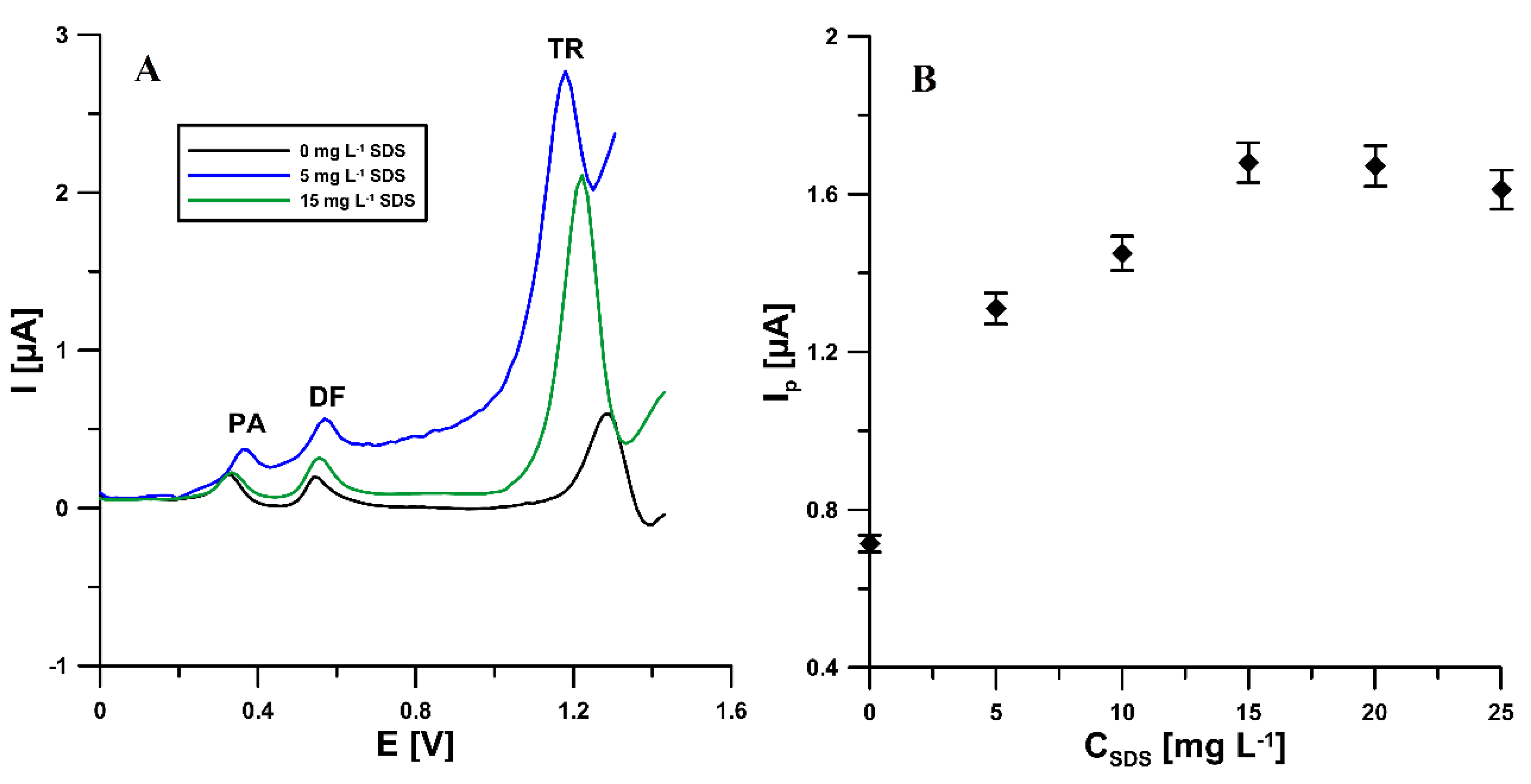
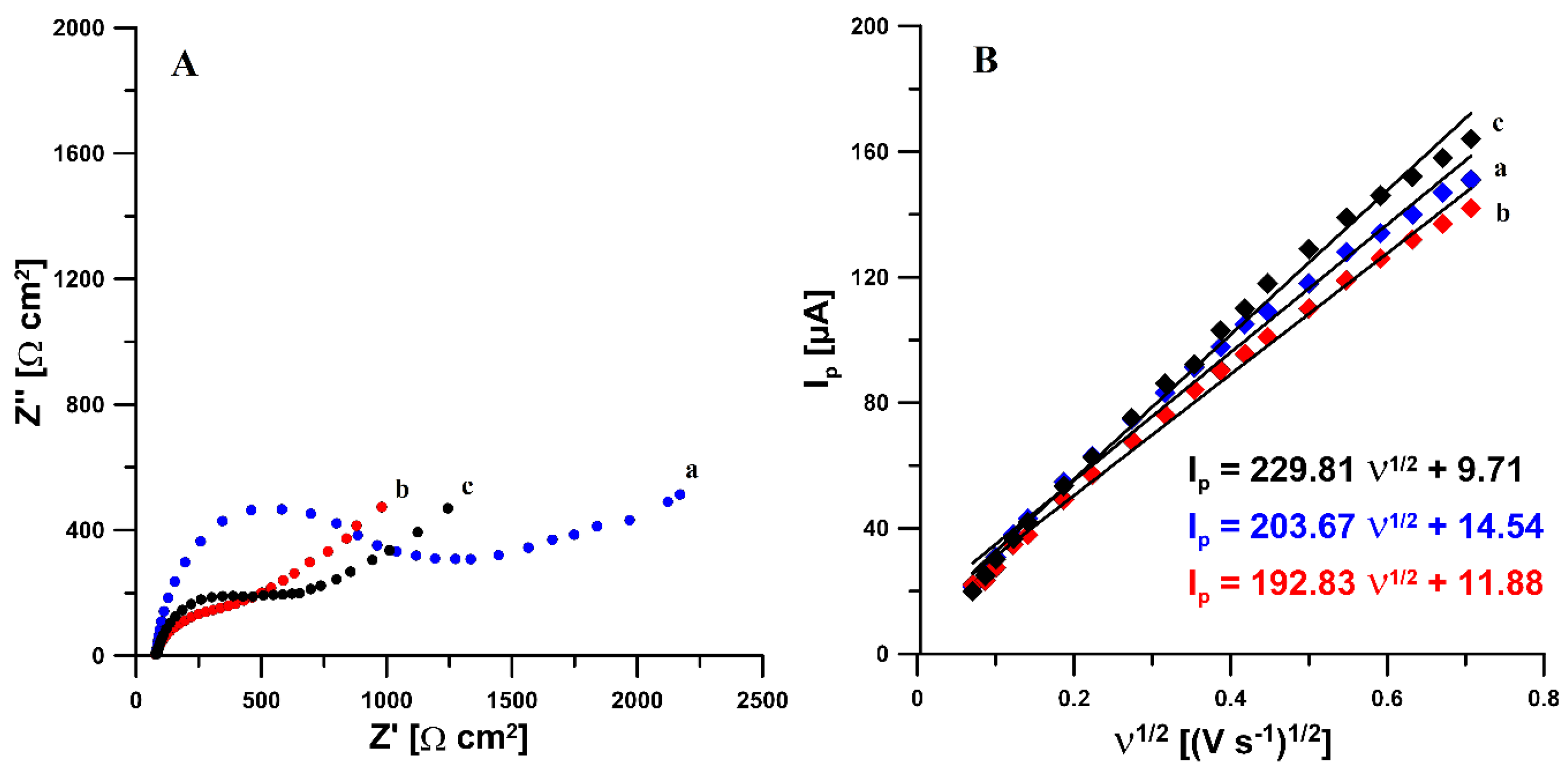
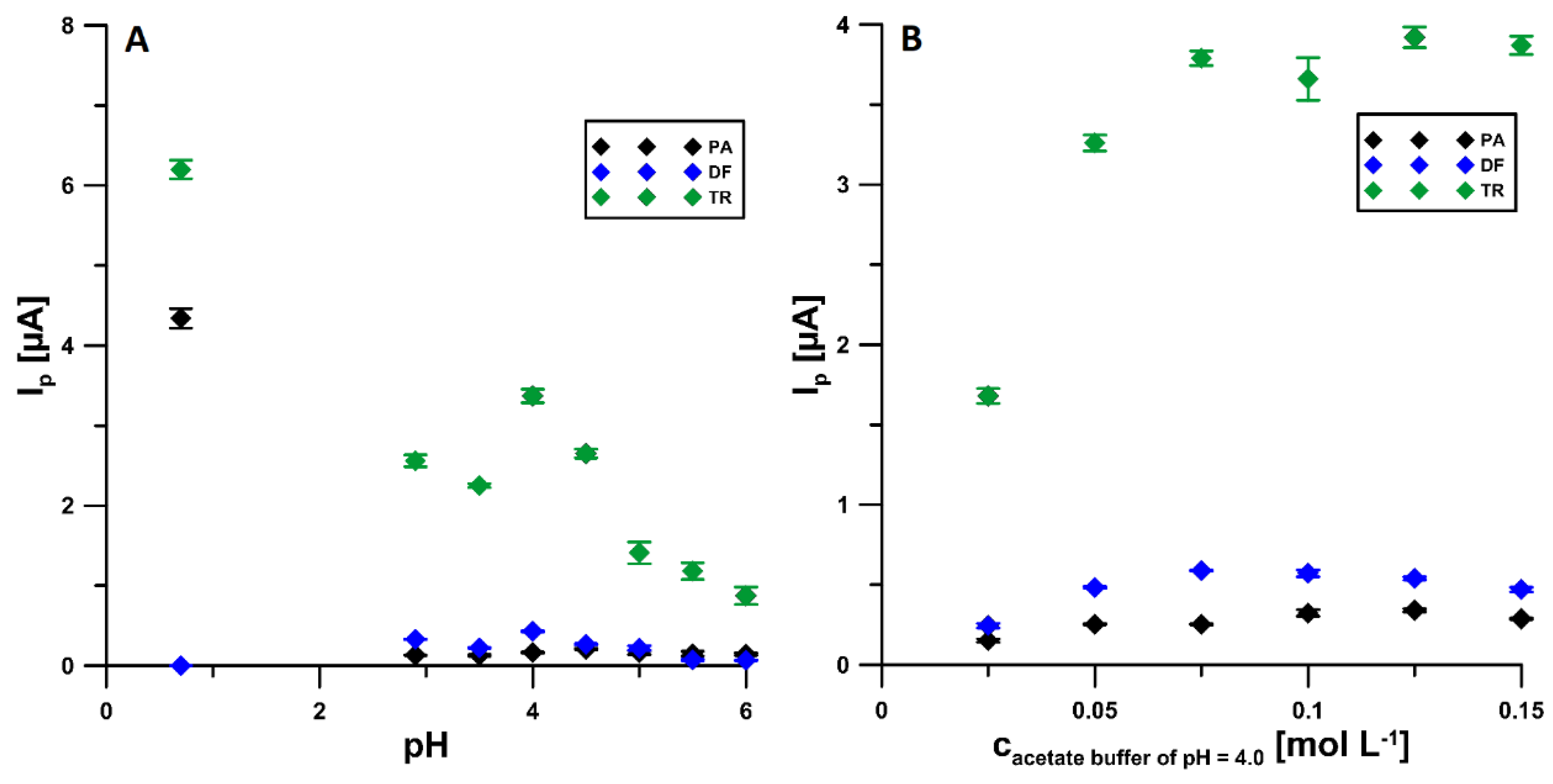
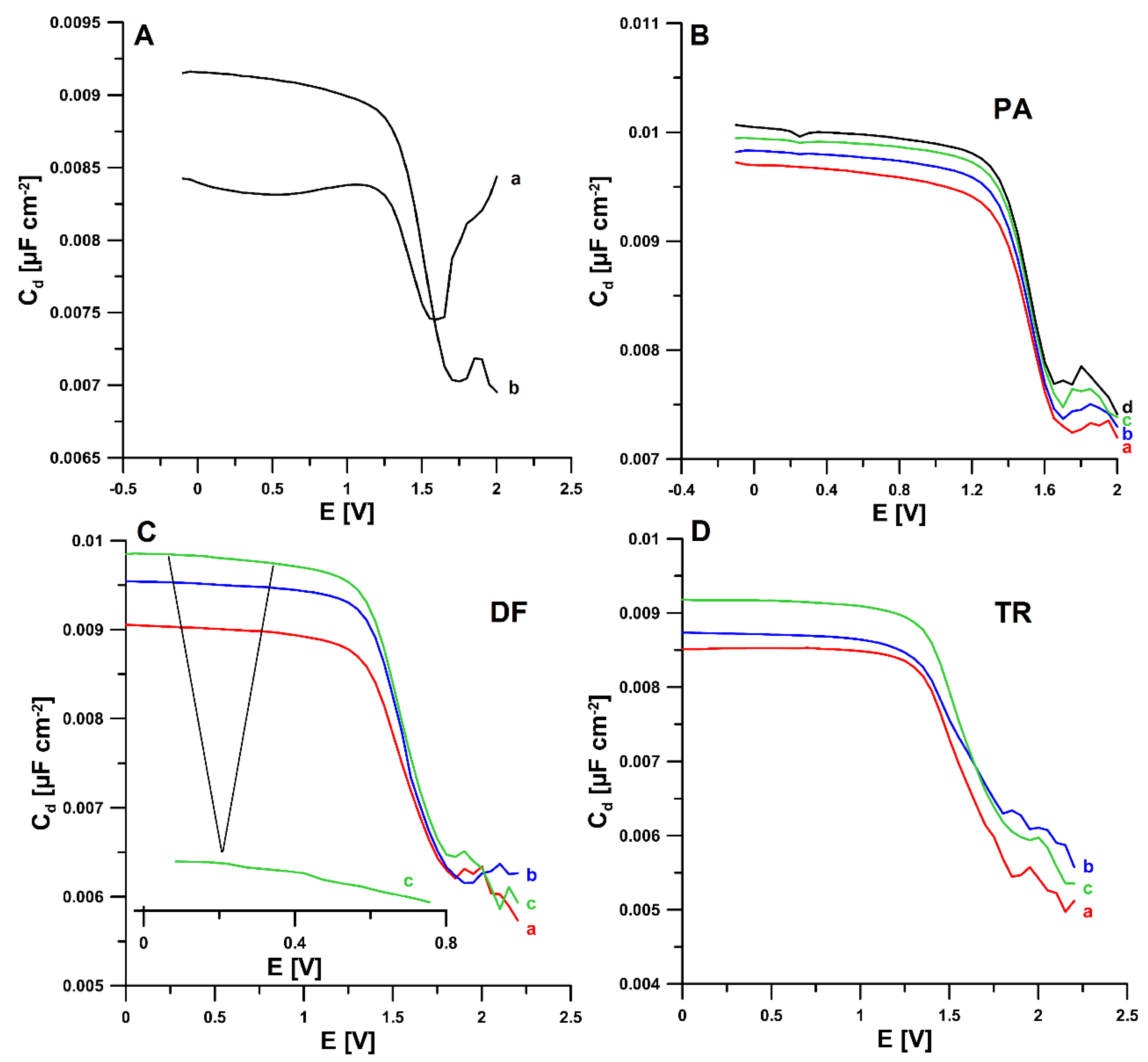
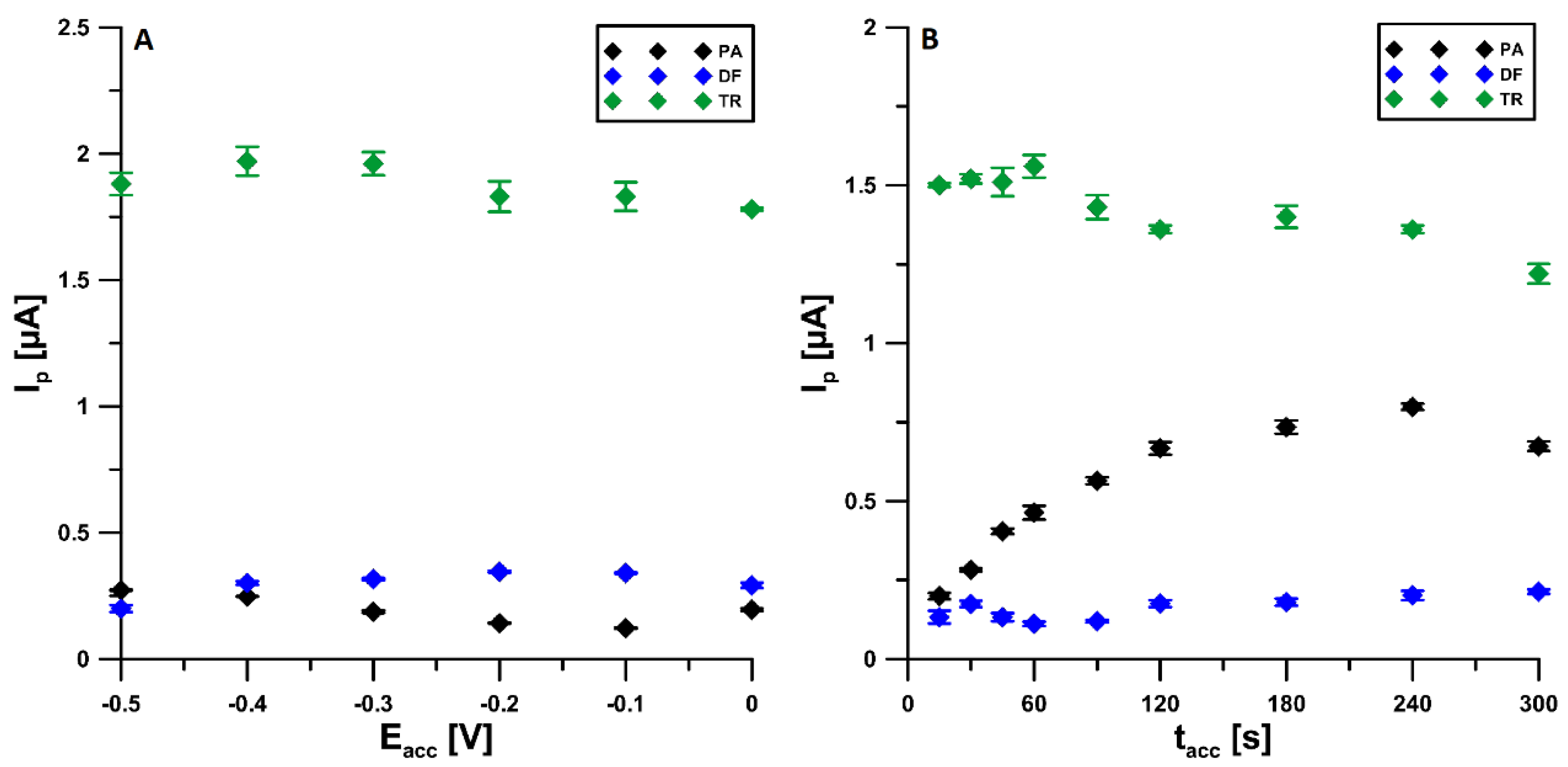
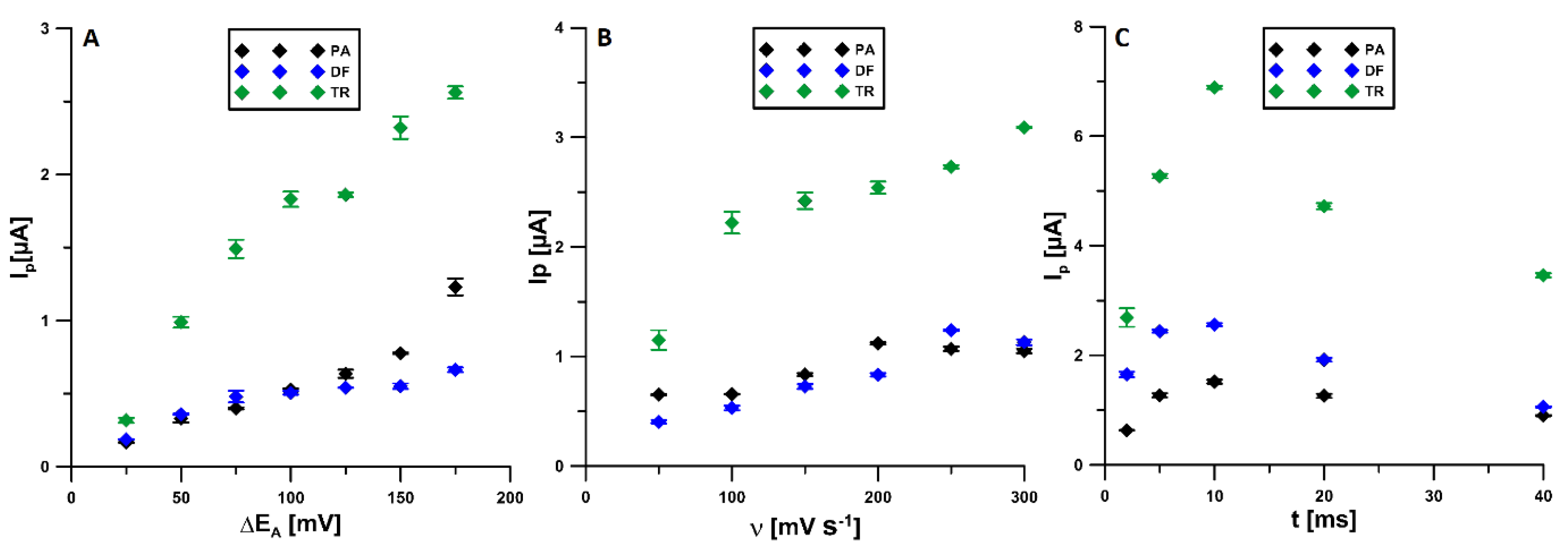
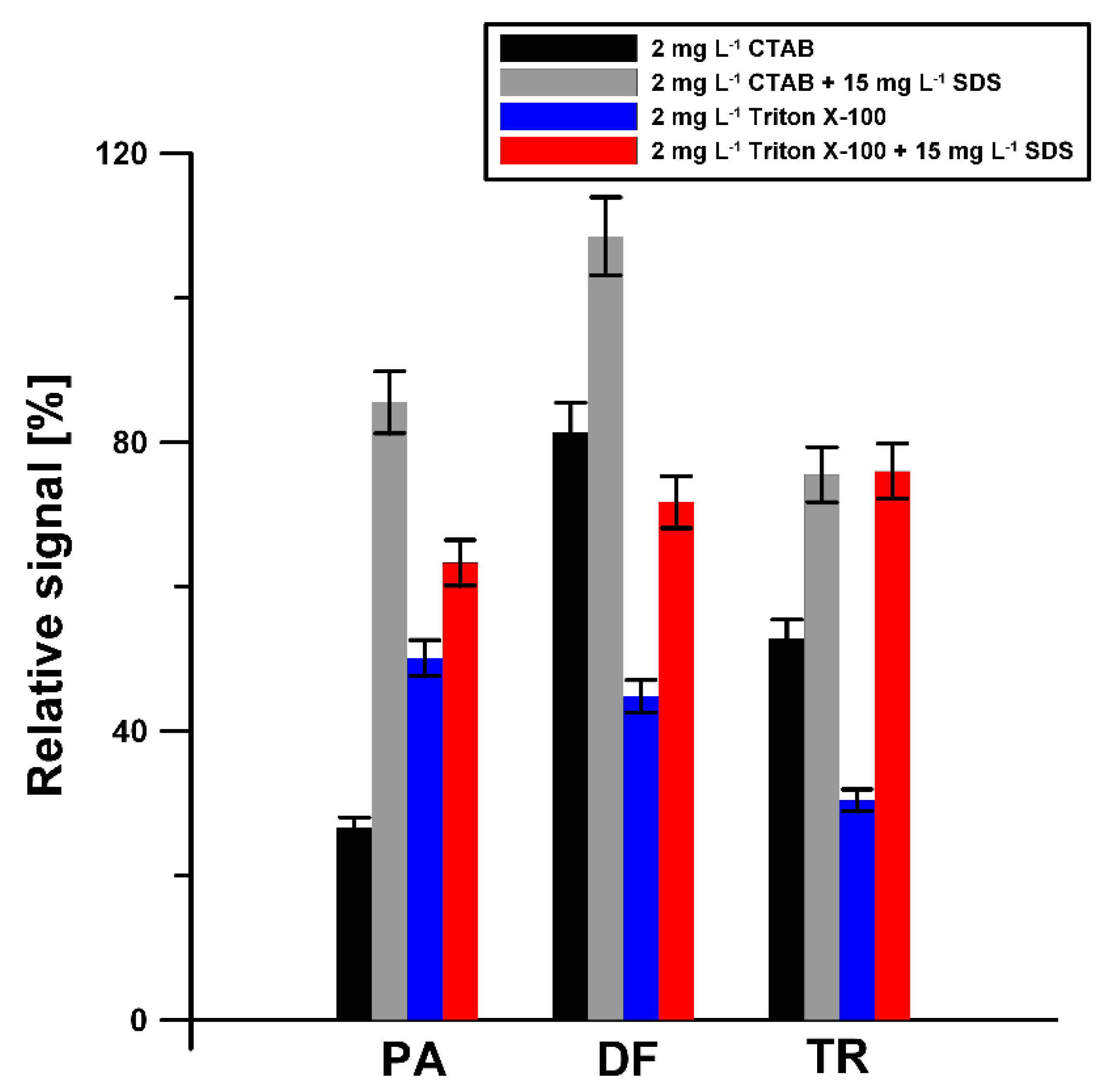

| Parameter | PA | DF | TR | PA, DF, and TR |
|---|---|---|---|---|
| Linear range (nmol L−1) | 50–100000 | 1–200 | 10–200 200–2000 | 50–20,000 (PA) |
| 1–200 (DF) | ||||
| 10–200 (TR) | ||||
| 200–2000 (TR) | ||||
| Calibration graph equation Ip (µA) cPA (µmol L−1) cDF (nmol L−1) cTR (µmol L−1) | Ip = 0.30cPA + 0.77 | Ip =14.27cDF + 0.063 | Ip = 5.95cTR + 0.33 Ip = 1.63cTR + 1.31 | Ip = 0.44cPA + 0.10 |
| Ip = 11.62cDF + 0.024 | ||||
| Ip = 5.51cTR + 0.34 | ||||
| Ip = 1.61 cTR + 1.23 | ||||
| Correlation coefficient (r) | 0.9947 | 0.9967 | 0.9940 0.9947 | 0.9983 (PA) |
| 0.9996 (DF) | ||||
| 0.9945 (TR) | ||||
| 0.9952 (TR) | ||||
| LOD (nmol L−1) | 12.93 | 0.12 | 2.47 | 14.87 (PA) |
| 0.21(DF) | ||||
| 1.71 (TR) | ||||
| LOQ (nmol L−1) | 43.09 | 0.39 | 8.24 | 49.56 (PA) |
| 0.69 (DF) | ||||
| 5.69 (TR) |
| Method | Analyte | Linear Range (mol L−1) | LOD (mol L−1) | Application | Ref. |
|---|---|---|---|---|---|
| HPLC | PA | 5.74 × 10−4–9.93 × 10−4 | 1.50 × 10−5 | Pharmaceutical formulations | [7] |
| HPLC | DF | 3.14 × 10−9–2.30 × 10−6 1.26 × 10−8–1.97 × 10−6 | 3.77 × 10−10 1.57 × 10−9 | Hospital wastewater, human serum | [8] |
| HPLC | TR | 1.67 × 10−8–1.0 × 10−6 | 5.33 × 10−10 | Urine, plasma | [9] |
| LC-MS/MS | PA | 8.28 × 10−7–3.31 × 10−4 | 2.21 × 10−8 | Human plasma | [10] |
| LC-MS/MS | DF | 1.57 × 10−8–3.14 × 10−5 | 6.29 × 10−9 | Cow plasma | [11] |
| LC-MS/MS | TR | 6.67 × 10−8–8.33 × 10−7 | 8.66 × 10−9 | Pharmaceutical formulations | [12] |
| GC-MS | PA | 4.97 × 10−4–3.31 × 10−3 | 1.32 × 10−4 | Pharmaceutical formulations | [47] |
| GC-MS | DF | 7.86 × 10−10–1.57 × 10−7 | 3.93 × 10−10 | Human plasma | [14] |
| GC-MS | TR | 1.50 × 10−9–1.0 × 10−6 1.83 × 10−8–8.33 × 10−7 8.33 × 10−9–1.0 × 10−6 | 1.50 × 10−98.33 × 10−92.67 × 10−9 | Plasma, urine, saliva | [15] |
| Spectrophotometry | PA | 0–9.94 × 10−4 | - | Pharmaceutical formulations | [16] |
| Spectrophotometry | DF | 1.57 × 10−5–2.52 × 10−4 | - | Pharmaceutical formulations | [17] |
| Spectrophotometry | TR | 5.67 × 10−6–1.43 × 10−5 | - | Pharmaceutical formulations | [18] |
| DPAdSV | PA DF | 5.0 × 10−8–2.0 × 10−5 1.0 × 10−9–2.0 × 10−7 | 1.49 × 10−82.10 × 10−10 | River water, human serum, | This work |
| TR | 1.0 × 10−8–2.0 × 10−7 2.0 × 10−7–2.0 × 10−6 | 1.71 × 10−9 | pharmaceutical formulations |
| Sample | PA Concentration (nmol L−1) ± SD (n = 3) | Recovery * (%) | ||
| Added | Found DPAdSV | Found HPLC/PDA | ||
| Bystrzyca river | 0 200 | <LOD 191 ± 9.0 | <LOD <LOD | - 97.0 |
| Human serum | 0 | <LOD | <LOD | - |
| 200 | 204 ± 1.2 | <LOD | 102.0 | |
| Sample | DF concentration (nmol L−1) ± SD (n = 3) | Recovery * (%) | ||
| Added | Found DPAdSV | Found HPLC/PDA | ||
| Bystrzyca river | 0 20 | <LOD 20.1 ± 0.2 | <LOD <LOD | - 100.5 |
| Human serum | 0 | <LOD | <LOD | - |
| 20 | 19.7 ± 1.0 | <LOD | 98.5 | |
| Sample | TR concentration (nmol L−10 ± SD (n = 3) | Recovery * (%) | ||
| Added | Found DPAdSV | Found HPLC/PDA | ||
| Bystrzyca river | 0 20 | <LOD 20.4 ± 0.6 | <LOD <LOD | - 102.0 |
| Human serum | 0 | <LOD | <LOD | - |
| 20 | 20.0 ± 0.4 | <LOD | 100.0 | |
| Tablets | Compound | Label Value (mg) | Determined DPAdSV (mg) ± SD (n = 3) | Relative Error * (%) |
|---|---|---|---|---|
| 1 | PA | 325.0 | 321.3 ± 3.8 | 1.1 |
| TR | 37.5 | 38.3 ± 2.1 | 2.1 | |
| 2 | DF | 25.0 | 25.0 ± 0.64 | 0.0 |
Publisher’s Note: MDPI stays neutral with regard to jurisdictional claims in published maps and institutional affiliations. |
© 2021 by the authors. Licensee MDPI, Basel, Switzerland. This article is an open access article distributed under the terms and conditions of the Creative Commons Attribution (CC BY) license (https://creativecommons.org/licenses/by/4.0/).
Share and Cite
Kozak, J.; Tyszczuk-Rotko, K.; Wójciak, M.; Sowa, I. Electrochemically Activated Screen-Printed Carbon Sensor Modified with Anionic Surfactant (aSPCE/SDS) for Simultaneous Determination of Paracetamol, Diclofenac and Tramadol. Materials 2021, 14, 3581. https://doi.org/10.3390/ma14133581
Kozak J, Tyszczuk-Rotko K, Wójciak M, Sowa I. Electrochemically Activated Screen-Printed Carbon Sensor Modified with Anionic Surfactant (aSPCE/SDS) for Simultaneous Determination of Paracetamol, Diclofenac and Tramadol. Materials. 2021; 14(13):3581. https://doi.org/10.3390/ma14133581
Chicago/Turabian StyleKozak, Jędrzej, Katarzyna Tyszczuk-Rotko, Magdalena Wójciak, and Ireneusz Sowa. 2021. "Electrochemically Activated Screen-Printed Carbon Sensor Modified with Anionic Surfactant (aSPCE/SDS) for Simultaneous Determination of Paracetamol, Diclofenac and Tramadol" Materials 14, no. 13: 3581. https://doi.org/10.3390/ma14133581
APA StyleKozak, J., Tyszczuk-Rotko, K., Wójciak, M., & Sowa, I. (2021). Electrochemically Activated Screen-Printed Carbon Sensor Modified with Anionic Surfactant (aSPCE/SDS) for Simultaneous Determination of Paracetamol, Diclofenac and Tramadol. Materials, 14(13), 3581. https://doi.org/10.3390/ma14133581






